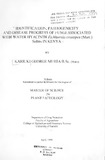Identification, pathogenicity and disease progress of fungi associated with water hyacinth Eichhornia crassipes (Mart.) Solms in Kenya.
Abstract
A survey of plant pathogenic fungi associated with naturally infected water
hyacinth tEichhornia crassipesi was conducted at 'Lake Victoria, Lake Naivasha
and Nairobi dam in Kenya. Twenty fungal isolates belonging to different genera
were isolated. Two Alternaria species designated WH3bl and WH3b2 were found
to be pathogenic to the water hyacinth during the preliminary green house studies.
The two exhibited different disease symptoms on the water hyacinth. On the basis
of conidial measurements, growth characteristics, and pigmentation in culture, the
two Alternaria species were identified as A. Alternata and A. eichhorniae.
,1. eichhomiae was found to be ideal for biological control both under green house
conditions and in the field. A. eichhorniae caused a severe disease characterised by leaf
blight and discrete leaf lesions. Disease symptoms appeared between the 5th and the ill
day following inoculation. For A. alternata, symptoms appeared 3 days after inoculation
as small yellowish, chlorotic lesions with necrotic brown centres. Later these lesions
enlarged gradually and centres turned dark brown with pale yellow margins. When the
two pathogens were compared for radial growth in three different solid media, A.
eichhorniae did well in water hyacinth leaf decoction agar as compared to potato
dextrose agar and V8 agar juice, while A. alternata grew fairly well in all the three.
Water hyacinth leaf decoction agar (WHLDA) was the best media for growth and
sporulation of A. eichhorniae.
Different broth media and cultural conditions were evaluated for the production
highly pathogenic inoculum of A. eichhorniae. Inoculum of A. eichhorniae grown
on fresh potato dextrose broth (FPOB) for 1 week under diurnal light followed by
another 1 week, under continuous darkness produced the highest disease
incidence and severity.
Histopathological studies were only done for A. eichhorniae. Serial microtome
sections of the inoculated leaves showed that the germinating conidia penetrated
the leaf in three ways; 1) the germ tube formed an appressorium followed by an
infection which punctured the epidermal cells, 2) the germ tube formed an
infection peg without an appressorium and penetrated the leaf between the guard
cell and epidermal cell and. 3) through the open stomata. Development of the
fungus in the host tissue was the same irrespective of the mode of penetration.
The fungus ramified through the host tissue both inter- and intra- cellularly
destroying the host cells. The air chambers in water hyacinth. which are regular in
shape. were seen to be irregular after 72 hours. This was followed by the
formation of necrotic spots.
Complete death and defoliation of water hyacinth plants infected with A.
eichhorniae occurred after the six week and disease development was noticed on
uninoculated water hyacinth plants grown in neighbouring plot O.5m away
suggesting dispersal of spores by either wind or water. The result of this study
suggests A .eichhorniae to be an aggressive pathogen on water hyacinth and
hence a potential for development of a bioherbicide for water hyacinth in in
Kenya
Citation
Kariuki, G M(1999). Identification, pathogenicity and disease progress of fungi associated with water hyacinth Eichhornia crassipes (Mart.) Solms in Kenya.Sponsorhip
University of NairobiPublisher
Department of Plant Science and Crop Protection, University of Nairobi
Description
Msc-Thesis

